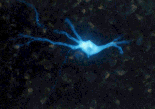| Sponsored by Wake Forest University School of Medicine and National Families in Action | |||
| Glossary - A | |||
| This glossary comes from False Messengers: How Addictive Drugs Change the Brain by David Friedman, PhD, and Sue Rusche, Harwood Academic Publishers, Amsterdam, The Netherlands, 1999. A | B
| C | D
| E | F
| G | H
| I |
|
|||
| A Absorption The process the body uses to move elements from the outside world into the blood and other tissues. Food is absorbed through the stomach and intestines. Nicotine is absorbed through the lungs. Abstinence The conscious choice not to use drugs. The term "abstinence" usually refers to the decision to end the use of a drug as part of the process of recovery from addiction. Acetaldehyde The metabolite that results when alcohol dehydrogenase breaks down alcohol in the body. Acetylcholine A neurotransmitter. Acetylcholine is used by spinal cord neurons to control muscles and by many other neurons in the brain as well. Nicotine binds to one type of acetylcholine receptor. Action potential The electrical part of a neuron's two-part, electrical-chemical message. An action potential consists of a brief pulse of electrical current that travels along the axon to relay messages over long distances. Acute effects The short-term effects of a drug. Acute effects are those that people feel shortly after they ingest a drug and are under its influence (e.g., while they are intoxicated). Adaptive behaviors Useful behaviors we acquire as we respond to the world around us. Adaptive behaviors help us get the things we want and need for life. Addiction A brain disorder characterized by the loss of control of drug-taking behavior, despite adverse health, social, or legal consequences to continued drug use. Addiction tends to be chronic and to be characterized by relapses during recovery. Addictive drugs Drugs that change the brain, change behavior, and lead to the loss of control of drug-taking behavior. Adenosine A neurotransmitter that binds to the adenosine receptor. Caffeine is an adenosine antagonist and prevents adenosine from binding with its receptor. Adrenal gland A small gland in the body that releases a variety of hormones that help us deal with stress. Two of these hormones, epinephrine and norepinephrine, are also part of the flight-or-fight response. Cocaine sharply increases the levels of these hormones in the body. Agonist A chemical that binds to a specific receptor and produces a response, such as excitation or inhibition of action potentials. Opiates, cannabis, nicotine, and some hallucinogens such as LSD are agonists. Alcohol A chemically simple, but psychoactively complex drug, commonly used in many beverages. Alcohol is a depressant drug with significant liability for abuse and addiction.
|
|
Alcohol dehydrogenase The enzyme found mainly in the liver and stomach that breaks down (metabolizes) alcohol. Alcoholics Anonymous One of the earliest forms of addiction treatment in the United States, AA developed the 12-step approach to assisting recovery from alcohol addiction (alcoholism). Several other anonymous groups have adapted the 12-step approach to help people recover from addiction to other drugs (e.g. Narcotics Anonymous, Cocaine Anonymous, Pot Smokers Anonymous). Alveoli Tiny, balloon-like air sacks in the lungs. Alveoli are designed to allow oxygen to pass rapidly into the blood and are also efficient at absorbing inhaled drugs. Alzheimer's disease A degenerative disease in which neurons of the brain die, leading to loss of the ability to think, learn, and remember (dementia). Amino acids Small chemical compounds that are the building blocks of proteins. Amphetamines Stimulant drugs whose effects are very similar to cocaine. Analgesics Drugs that relieve pain. Analogs Drugs whose chemical structures have been slightly modified from a parent compound. There are many analogs to morphine or LSD. See Designer drug. Anandamide The endogenous neurotransmitter that binds to the cannabinoid receptor. Anesthesia The loss of sensation, primarily to pain, often accompanied by the loss of consciousness. Anesthetic gases Gaseous drugs that produce loss of sensation and consciousness. Antagonist A chemical that binds to a receptor and blocks it, producing no response, and preventing agonists from binding, or attaching, to the receptor. Antagonists include caffeine and naloxone. Assessment The diagnostic process in which a professional examines a drug user to determine the extent of the person's drug use, whether he or she is addicted, and what type of treatment might be most effective. Auditory cortex The part of the cerebral cortex that processes sounds and produces our awareness of them. Axon The cable-like structure neurons used to send messages to other neurons. It carries the neuron's electrical message. Axon terminal The structure at the end of an axon that produces and releases chemicals (neurotransmitters) to transmit the neuron's message across the synapse to another neuron. |
|
| Home | For Journalists | For the States | Science Update | Links | Glossary | About |
Last
Revision
info@addictionstudies.org

